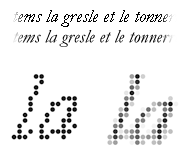Staircase effect
As stairs (stages) effect (also fragment effects or raster conversion effect ) is in the computer graphics , the "stair-step" appearance at the edges rasterized referred figures.
The step effect is not a consequence of the raster algorithm itself, but is caused by the finite image resolution of the graphics device. Therefore, the appearance of affected objects is also described as " pixelated ". It is particularly irritating with animations, since small objects seem to move with noticeable jerks. Although the staircase effect is often described in the specialist literature as a consequence of the alias effect , it is not an alias effect in the conventional sense of signal analysis , in which a high frequency appears as a disturbing lower frequency. The staircase effect can be reduced through higher image resolution and through anti-aliasing , also known as edge smoothing. On some screens, the staircase effect can also be reduced by subpixel rendering .
Figures can only be displayed with the help of vector screens or plotters without the staircase effect .
literature
- Alan Watt: 3D Computer Graphics, p. 397 f. Addison-Wesley, Harlow 2000, ISBN 0-201-39855-9
